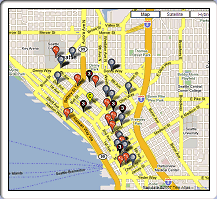Under the International Standards Organization’s Open Systems Interconnection (OSI) model, Ethernet is fundamentally a Layer 2 protocol. 10 Gigabit Ethernet uses the IEEE 802.3 Ethernet Media Access Control (MAC) protocol, the IEEE 802.3 Ethernet frame format, and the minimum and maximum IEEE 802.3 frame size.
Just as 1000BASE-X and 1000BASE-T (Gigabit Ethernet) remained true to the Ethernet model, 10 Gigabit Ethernet continues the natural evolution of Ethernet in speed and distance. Since it is a full-duplex only and fiber-only technology, it does not need the carrier-sensing multiple-access with collision detection (CSMA/CD) protocol that defines slower, half-duplex Ethernet technologies. In every other respect, 10 Gigabit Ethernet remains true to the original Ethernet model.
An Ethernet PHYsical layer device (PHY), which corresponds to Layer 1 of the OSI model, connects the media (optical or copper) to the MAC layer, which corresponds to OSI Layer 2. Ethernet architecture further divides the PHY (Layer 1) into a Physical Media Dependent (PMD) and a Physical Coding Sublayer (PCS). Optical transceivers, for example, are PMDs. The PCS is made up of coding (e.g., 64/66b) and a serializer or multiplexing functions.
The 802.3ae specification defines two PHY types: the LAN PHY and the WAN PHY. The WAN PHY has an extended feature set added onto the functions of a LAN PHY. These PHYs are solely distinguished by the PCS. There will also be a number of PMD types.
The accelerating growth of worldwide network traffic is forcing service providers, enterprise network managers and architects to look to ever higher-speed network technologies in order to solve the bandwidth demand crunch. Today, these administrators typically use Ethernet as their backbone technology.
Although networks face many different issues, 10 Gigabit Ethernet meets several key criteria for efficient and effective high-speed networks:
• Easy, straightforward migration to higher performance levels without disruption,
• Lower cost of ownership vs. current alternative technologies – including both acquisition and support costs
• Familiar management tools and common skills base
• Ability to support new applications and data types
• Flexibility in network design
• Multiple vendor sourcing and proven interoperability
Managers of enterprise and service provider networks have to make many choices when they design networks. They have multiple media, technologies, and interfaces to choose from to build campus and metro connections: Ethernet (100, 1000, and 10,000 Mbps), OC-12 (622 Mbps) and OC-48 (2.488 Gbps), SONET or equivalent SDH network, packet over SONET/ SDH (POS), and the newly authorized IEEE 802 Task Force (802.17) titled Resilient Packet Ring.
Network topological design and operation has been transformed by the advent of intelligent Gigabit Ethernet multi-layer switches. In LANs, core network technology is rapidly shifting to Gigabit Ethernet and there is a growing trend towards Gigabit Ethernet networks that can operate over metropolitan area distances.
The next step for enterprise and service provider networks is the combination of multi-gigabit bandwidth with intelligent services, leading to scaled, intelligent, multi-gigabit networks with backbone and server connections ranging up to 10 Gbps.
In response to market trends, Gigabit Ethernet is currently being deployed over tens of kilometers in private networks. With 10 Gigabit Ethernet, the industry has developed a way to not only increase the speed of Ethernet to 10 Gbps but also to extend its operating distance and interconnectivity. In the future, network managers will be able to use 10 Gigabit Ethernet as a cornerstone for network architectures that encompass LANs, MANs and WANs using Ethernet as the end-to-end, Layer 2 transport method.
Ethernet bandwidth can then be scaled from 10 Mbps to 10 Gbps – a ratio of 1 to 1000 — without compromising intelligent network services such as Layer 3 routing and layer 4 to layer 7 intelligence, including quality of service (QoS), class of service (CoS), caching, server load balancing, security, and policy based networking capabilities. Because of the uniform nature of Ethernet across all environments when IEEE 802.3ae is deployed, these services can be delivered at line rates over the network and supported over all network physical infrastructures in the LAN, MAN, and WAN. At that point, convergence of voice and data networks, both running over Ethernet, becomes a very real option. And, as TCP/IP incorporates enhanced services and features, such as packetized voice and video, the underlying Ethernet can also carry these services without modification.
As we have seen with previous versions of Ethernet, the cost for 10 Gbps communications has the potential to drop significantly with the development of new technologies. In contrast to 10 Gbps telecommunications lasers, the 10 Gigabit Ethernet short links — less than 40km over single-mode (SM) fiber — will be capable of using lower cost, uncooled optics and, in some cases, vertical cavity surface emitting lasers (VCSEL), which have the potential to lower PMD costs. In addition, the industry is supported by an aggressive merchant chip market that provides highly integrated silicon solutions. Finally, the Ethernet market tends to spawn highly competitive start-ups with each new generation of technology to compete with established Ethernet vendors.
10 Gigabit Ethernet in the Metro
Vendors and users generally agree that Ethernet is inexpensive, well understood, widely deployed and backwards compatible from Gigabit switched down to 10 Megabit shared. Today a packet can leave a server on a short-haul optic Gigabit Ethernet port, move cross-country via a DWDM (dense wave division multiplexing) network, and find its way down to a PC attached to a “thin coax” BNC (Bayonet Neill Concelman) connector, all without any re-framing or protocol conversion. Ethernet is literally everywhere, and 10 Gigabit Ethernet maintains this seamless migration in functionality.
Gigabit Ethernet is already being deployed as a backbone technology for dark fiber metropolitan networks. With appropriate
10 Gigabit Ethernet interfaces, optical transceivers and single mode fiber, service providers will be able to build links reaching 40km or more. (See Figure 4.)
10 Gigabit Ethernet in Local Area Networks
Ethernet technology is already the most deployed technology for high performance LAN environments. With the extension of 10 Gigabit Ethernet into the family of Ethernet technologies, the LAN now can reach farther and support up coming and bandwidth hungry applications. Similar to Gigabit Ethernet technology, the 10 Gigabit proposed standard supports both singlemode and multi-mode fiber mediums. However in 10 Gigabit Ethernet, the distance for single-mode fiber has expanded from the 5km that Gigabit Ethernet supports to 40km in 10 Gigabit Ethernet.
The advantage for the support of longer distances is that it gives companies who manage their own LAN environments the option of extending their data centers to more cost-effective locations up to 40km away from their campuses. This also allows them to support multiple campus locations within that 40km range. Within data centers, switch-to-switch applications, as well as switch to server applications, can also be deployed over a more cost effective multi-mode fiber medium to create 10 Gigabit Ethernet backbones that support the continuous growth of bandwidth hungry applications. (See Figure 5.)
With 10 Gigabit backbones installed, companies will have the capability to begin providing Gigabit Ethernet service to workstations and, eventually, to the desktop in order to support applications such as streaming video, medical imaging, centralized applications, and high-end graphics. 10 Gigabit Ethernet will also provide lower network latency due to the speed of the link and over-provisioning bandwidth to compensate for the bursty nature of data in enterprise applications.
Links of interest:
- Ethernet Whitepapers
- USA Business & Carrier Metro Ethernet
- Metro Wave Division Multiplexing, DWDM Services and DWDM/ROADM
- Business Phone Systems (external)
- International WAN & DIA Services
- Wholesale SIP Termination (carrier & enterprise)
If you found this page helpful, please support us by bookmarking us with one of the services below or by linking to this page.
- Gigabit Ethernet
- metropolitan area network
- 10ge
- 10 GE
- Metropolitan Optical Ethernet
- metropolitan area networks
- imagenes de giga ethernet
- local area network
- optical fiber 10ge
- global wan design
No related posts.










